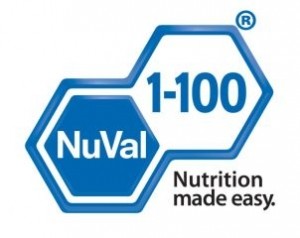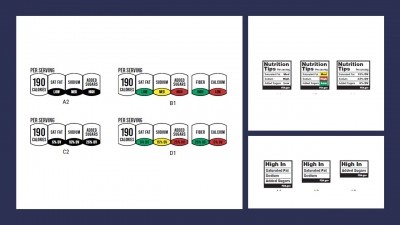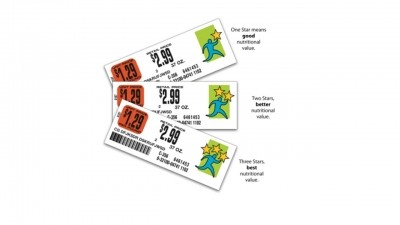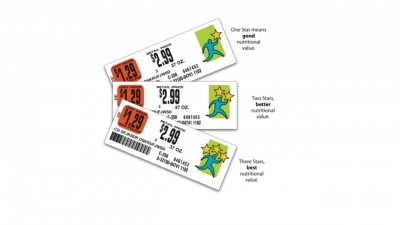Goodbye NuVal… and good riddance?
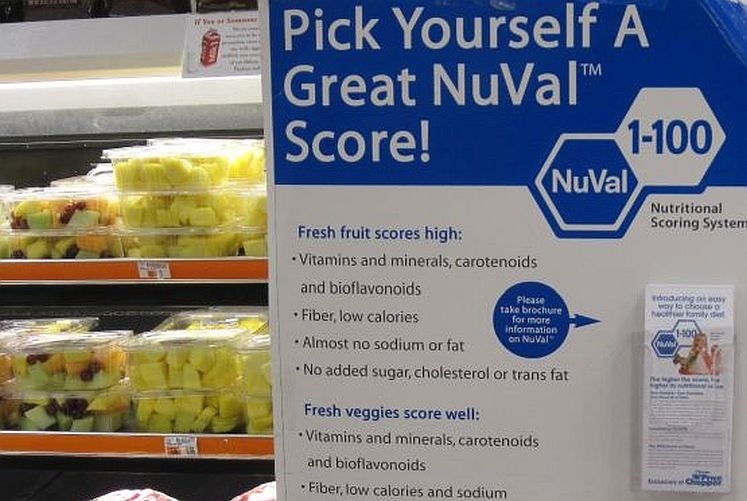
NuVal – which at its peak featured in 1,600+ stores in 31 states including Tops Friendly Marks in New York, Raley’s in California and Big Y in Massachusetts – factored in positive nutritional attributes as well as negative ones, with nutrients with generally favorable effects on health (eg. vitamins) increasing the score, while nutrients with generally unfavorable effects (trans fat, excess sodium) decreasing the score.
As with any system attempting to apply a standardized approach to thousands of foods across multiple categories, however, it threw up some strange results (read more here at USA Today and Yale Daily News), and attracted criticism from some big CPG brands and the National Consumers League (NCL) due to its refusal to publish the algorithms underpinning its scores.
“The NuVal rating system was fatally flawed, and its removal from grocery store shelves is a win for consumers,” said NCL executive director Sally Greenberg.
“Its proprietary algorithmic formula – which was not made transparent to consumers or the scientific community – resulted in snack chips, soft drinks, and desserts being given as high or higher nutritional scores than some canned fruits and vegetables. We welcome the news that NuVal has been discontinued nationally.”
NuVal has not responded to requests for comment, but according to its website, it is now focused on the NuVal attributes program, which guides consumers to foods and beverages with specific attributes such as gluten-free, organic or low sodium, but does not ascribe a score/points to individual products.
RD: 'This doesn't actually teach consumers anything'
But what do dietitians think about NuVal’s demise? Was its particular algorithm “fatally flawed” as Greenberg contends, or will there be problems with any system that attempts to ‘rank’ food and beverage products?
Andy Bellatti, Las Vegas-based RD, told FoodNavigator-USA that, "Nutrition scoring systems can potentially help consumers, but there are some problematic issues at play, too."
He added: "First, each scoring system has its own formula (which is usually proprietary and kept hidden from consumers). If a formula is based on outdated or murky science (i.e.: any high-fat food, regardless of type of fat, is penalized), it isn't necessarily promoting the healthiest foods out there.
"Second, many of these systems do not take into account ingredients. Nowadays, food manufacturers can use all sorts of nutritionally-empty or even potentially harmful ingredients to tweak values that appear on the Nutrition Facts label to make a product score well.
"Third, this doesn't actually teach consumers anything. Once the scoring system is discontinued, or if a consumer goes to a store where the scoring system isn't used, they don't necessarily have the knowledge to determine what makes a healthful product.
"At the end of the day, I just can't behind the idea that we need complex mathematical equations to determine that lentils are healthful and a high-sugar protein bar isn't a very healthful choice."
A scoring system works best on the day as a whole
Linn Steward, RDN CDN, a New York based registered dietitian, echoed many of Bellatti's concerns: "Conceptually, I like the idea of scoring systems, but I see some barriers to overcome.
"The first barrier I see is the lack of a big picture. A scoring system works best on the day as a whole, even better as a running average over several days. Thinking about the day as a whole is not easy for most folks and that’s a problem. An individual item can be really high in salt or saturated fat but averaged into a day or a couple of days it’s okay. It's very hard to label an individual product based on how it fits into a day because every person has a different day. Like I used to tell my clients when I did counseling in a corporate fitness club - it’s what you eat most days that counts."
NuVal was a nutrient-centric scoring algorithm, she noted. "Hybrid scoring systems like the healthy eating index or the new French system score both nutrients and food groups, and are more comprehensive and more intuitive because these systems score foods as well as nutrients. A nutrient based algorithm to calculate a negative score and a food based algorithm to calculate a positive score is an improvement over NuVal."
The second barrier is motivation, she added. "How do you reach the 'it’s just lunch' crowd? Virtually all the clients I had in corporate wellness or rehab for that matter came to get advice on weight loss. I counseled healthy eating but my clients paid me for weight loss. For a scoring system to work for shoppers or consumers, it helps if folks want to eat healthier. If they are looking for something more than the shortest line or the cheapest price. That’s hard enough to do in a one on one setting let alone on with signs or color codes."
So what's the answer? "I like the dietitians choice approach adopted by Coborn's. Accentuating the positive. This one is healthier than that one. Simple and helpful. Hopefully too having RDNs in the store will generate more interaction. It’s much easier to care about something if you can interact with people who are there to explain why healthy is important."
A balanced diet is about the overall meal pattern for your dietary needs, not just one food
Caroline West Passerrello, MS, RDN, LDN, a Registered Dietitian Nutritionist and spokesperson for the Academy of Nutrition and Dietetics, told us that any nutrient-based ranking system is inherently problematic.
"Front of pack labeling or shelf-labeling programs that utilize one symbol or a number for ranking purposes only take into account the nutrients in that food. A balanced diet is about the overall meal pattern for your dietary needs, not just one food."

But what about the industry-backed Facts up Front scheme?
It's not designed to provide-a-glance information about how healthy a product is, but by calling out nutrients of concern as well as a couple of nutrients to encourage on the front of pack, consumers "may be more likely to pick up the product, turn it over and read the full nutrition facts panel - including the ingredients – to aid their purchasing decision," she said.
"With the growth of online grocery shopping, there will be opportunities to provide real valuable nutrition information at the point of purchase."
RD: 'Food scoring systems are not the answer'
“As a Registered Dietitian who understands nutrition science and its nuances, I would love to see everyone trained in nutrition, but it isn't going to happen,” added Catherine Adams Hutt, PhD, RD, CFS, and principal at consultancy RdR Solutions.
“Yet, food scoring systems are not the answers either. No matter how elegant and ‘science-based’ the algorithms are that support the score... scores, grades, and traffic lights are simply too complicatedly simplistic…
“The answer lies somewhere in between Michael Pollan's recommendation, ‘Eat food, not too much’ and complicated algorithms that integrate public policy, human biases, and selective science.”
Front of pack labeling
In a 2011 report, the Institute of Medicine argued that front-of-pack schemes should interpret nutrition information for consumers at a glance, and recommends listing calories per serving as well as a rating of zero to three 'nutritional points' based on levels of saturated and trans fats, sodium, and added sugars. While this was welcomed by some healthy advocacy groups, it was also criticized for only taking 'bad' nutrients into account, rather than a product's overall nutrient density.
The industry-backed Facts Up Front program, meanwhile, spells out calories, sat fat, sodium and sugar per serving, and gives manufacturers the option to mention two ‘nutrients to encourage,’ but does not rate or ‘rank’ products with colors, stars or numbers/scores.
Other schemes, such as Guiding Stars, attribute stars to products based on nutrient density, while others, such as Walmart's 'Great for You' scheme, award stamps to the healthiest products.

